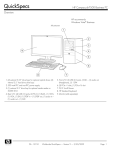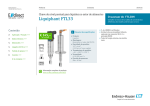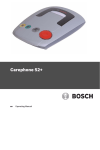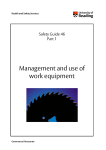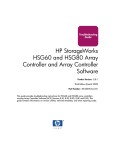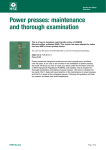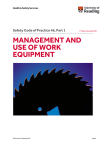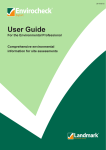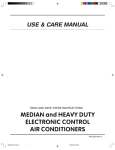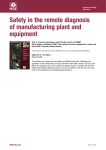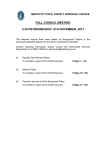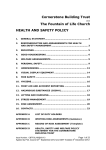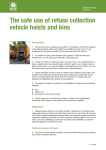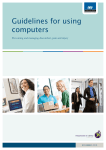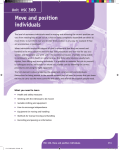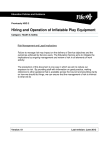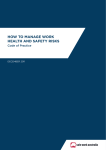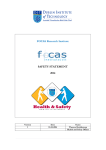Download Caring for cleaners - Health and Safety Works NI
Transcript
Health and Safety Executive Caring for cleaners Guidance and case studies on how to prevent musculoskeletal disorders This is a free-to-download, web-friendly version of HSG234 (First edition, published 2003). This version has been adapted for online use from HSE’s current printed version. You can buy the book at www.hsebooks.co.uk and most good bookshops. ISBN 978 0 7176 2682 3 Price £9.50 This publication is designed for all those involved in the management of health and safety in the cleaning industry. It will be useful for employers, managers/supervisors, health and safety personnel, trainers, safety and union representatives and cleaners themselves. Guidance is provided on recognising and controlling the manual handling and upper limb risks faced by cleaners at work. A number of case studies are also provided, focusing on how organisations have reached a solution. Many of the solutions suggested are simple cost-effective measures that were developed through co-operation between supervisors, managers, safety representatives and cleaners. By applying the guidance in this book, workrelated ill health and injuries suffered by cleaners can be significantly reduced. HSE Books Page 1 of 58 Health and Safety Executive © Crown copyright 2003 First published 2003 ISBN 978 0 7176 2682 3 All rights reserved. No part of this publication may be reproduced, stored in a retrieval system, or transmitted in any form or by any means (electronic, mechanical, photocopying, recording or otherwise) without the prior written permission of the copyright owner. Applications for reproduction should be made in writing to: The Office of Public Sector Information, Information Policy Team, Kew, Richmond, Surrey TW9 4DU or e-mail: [email protected] This guidance is issued by the Health and Safety Executive. Following the guidance is not compulsory and you are free to take other action. But if you do follow the guidance you will normally be doing enough to comply with the law. Health and safety inspectors seek to secure compliance with the law and may refer to this guidance as illustrating good practice. Page 2 of 58 Health and Safety Executive Contents Preface 5 Section 1 What this book is about 6 Who should read this book? 6 What are musculoskeletal disorders? 6 Why are cleaners at risk? 6 How do you know if there is a problem 7 What to do if symptoms occur 7 What are the main factors that give rise to problems among cleaners? 7 Manual handling tasks 8 Awkward postures 8 Work organisation 8 Using vibrating equipment 9 Accidents 9 Section 2 Managing the risks 10 Risk assessment 10 Who should do what 10 Trainers 11 Section 3 Case studies 12 Introduction 12 Equipment changes 13 1 Alternative equipment to reduce forces required 13 2 Introduction of equipment to move materials 15 3 Provision of equipment to accommodate all workers 17 4 Equipment adaptations to improve suitability for work environment 18 5 Provision of sufficient equipment for cleaners 20 6 Maintenance of equipment 21 Training changes 23 7 Designing training programmes for cleaners 23 8 Introduction of different working techniques 25 Workplace changes 26 9 Making changes to the workplace 26 Work organisation changes 28 10 Job enlargement for the cleaner 28 11 Teamwork 29 12 Making daytime cleaning work 30 Occupational health management 31 13 Contract cleaning agency as change agent 31 14 Introduction of robotic equipment to clean the workplace 32 15 Designing in the needs of the cleaner 34 16 Reporting ill health - Is there a pain and discomfort problem in your organisation? 36 Section 4 Useful tips 38 Workplace changes 38 Cleaning agents/materials 39 Work organisation changes 41 Protective clothing 41 Equipment 42 Caring for cleaners: Guidance and case studies on how to prevent musculoskeletal disorders Page 3 of 58 Health and Safety Executive Appendices 47 Appendix 1: Checklists 47 Equipment checklist 47 Maintenance checklist 49 Postural checklist 50 Workplace and environment checklist 51 Work and work organisation checklist 52 Appendix 2: Cleaners’ health questionnaire 53 Acknowledgements 54 Contributors 54 References 55 References and further information 55 Websites 56 Cleaning trade associations 57 Training organisations 57 Caring for cleaners: Guidance and case studies on how to prevent musculoskeletal disorders Page 4 of 58 Health and Safety Executive Preface High levels of musculoskeletal problems (muscular aches, pains and discomfort) have been found among cleaners in a number of studies, both in this country and in Europe. The level of such health problems is high among cleaners compared to other wage earners. The Government and the Health and Safety Commission (HSC) have set targets to reduce the number of days lost through illness and injury at work. This is being taken forward through the Revitalising health and safety strategy statement and HSE’s long-term occupational health strategy, Securing health together. By applying the guidance here, work-related ill health and injuries suffered by cleaners can be significantly reduced. Caring for cleaners: Guidance and case studies on how to prevent musculoskeletal disorders Page 5 of 58 Health and Safety Executive What this book is about Who should read this book? This book is designed for all those involved in the management of health and safety in the cleaning industry: employers, managers/supervisors, health and safety personnel, trainers, safety and union representatives and cleaners themselves. In addition, equipment manufacturers, designers and suppliers should be aware of the good practice and design tips that it suggests. This book is about recognising and controlling the manual handling and upper limb risks faced by cleaners at work. Section 2 gives general guidance on this. Section 3 contains case studies of solutions showing effective ways in which risks have been reduced. Many of the solutions are simple cost-effective measures that were developed through co-operation between supervisors, managers, safety representatives and cleaners. In addition to the case studies, Section 4 lists a number of useful ideas drawn from across the industry, many coming directly from cleaners themselves. Finally the References section lists relevant publications, further guidance, information sources and contact addresses. What are musculoskeletal disorders? The term ‘musculoskeletal disorder’ describes a variety of strain, sprain, and overuse problems affecting the body’s muscles, joints and nerves. The back, neck, shoulders and upper limbs are particularly at risk. Problems include everything from backache and slipped discs, to upper limb disorders, tenosynovitis, pain, numbness, swelling and tingling in the hands and wrists. These conditions are often caused or made worse by work activities. Musculoskeletal disorders are the most common form of work related ill health in Great Britain. There are an estimated 12 million working days lost each year through musculoskeletal disorders caused or made worse by work with sufferers taking 19 days off on average. Why are cleaners at risk? Cleaning work is demanding and labour intensive. Changes within the industry mean that cleaners increasingly work under severe time constraints. Many tasks involve heavy manual work, putting strain on the heart, muscles and other tissues. Cleaners are often required to work in awkward postures for long periods and this may lead to long-term damage. In addition to using cleaning machines, there is a lot of hard manual work including mopping, wiping surfaces, polishing, moving rubbish bags, furniture and equipment. Cleaners work in buildings which are generally planned for other workers and not designed with cleaning in mind where issues such as access, the location of taps and storage facilities, and the use of unsuitable floor materials pose problems for cleaners. Caring for cleaners: Guidance and case studies on how to prevent musculoskeletal disorders Page 6 of 58 Health and Safety Executive How do you know if there is a problem? Important indications of musculoskeletal problems in the workplace are: Q Q Q Q Q Q Q Q an increase in sickness absence; reports of pain and discomfort from cleaners; reports of problems from safety/union representatives; low motivation and dissatisfaction among cleaners; cleaners having made their own adaptations to equipment; cleaners wearing splints, bandages or back support belts; an increase in accident and injury reports; an unwillingness by workers to perform a specific task or tasks. What to do if symptoms occur Symptoms may occur suddenly, or there may be a more gradual onset of symptoms with initial tingling, then slight swelling or soreness, which may persist and gradually worsen. In most cases, sufferers should stay active, avoid putting undue pressure or stress on the damaged area, try simple pain relief and if discomfort persists, seek medical advice. When symptoms are not addressed sufferers may adopt new ways of performing tasks, or adapt tools to reduce discomfort, perhaps avoiding use of the affected limb and so putting strain on other joints. The most serious cases can result in permanent disablement and job change or loss if action is not taken in time. It is therefore critical that staff report the earliest symptoms so that they can be encouraged to receive prompt medical treatment if needed and that suitable rehabilitation is made available. Rehabilitation in such circumstances helps sufferers return to work and reduces sickness absence, retains experienced staff and avoids more serious illness leading to longer term absence or compensation claims. Carrying this out by management of individual cases is particularly effective. What are the main factors that give rise to musculoskeletal problems among cleaners? Musculoskeletal problems may arise from: Q physical factors (eg heavy, static or monotonous work, extreme or constrained postures, repetitive movements, unsuitable workplaces and equipment, forces, exposure to vibration); Q psychosocial factors (eg work organisation, interpersonal relationships, short cycle tasks, poor work control, piece-rate payment system, poor management, unsatisfactory training, lack of breaks); Q personal factors (eg gender, age, seniority, exercise habits, lifestyle, psychological characteristics and capacities). Concentrating only on physical factors may not be as effective in reducing sickness absence, pain and discomfort as an approach that also takes into account psychosocial and personal factors. While not all musculoskeletal problems are caused by work, musculoskeletal risks in cleaning arise from various activities. Caring for cleaners: Guidance and case studies on how to prevent musculoskeletal disorders Page 7 of 58 Health and Safety Executive Manual handling tasks Manual handling includes pushing and pulling; lifting and lowering; carrying and holding; loading and unloading; holding and restraining; reaching and holding; grasping and throwing; and operating levers and controls where force is required. Causes of problems Q Q Q Q Q Q Q Q Q Q lifting and moving heavy weights poor lifting methods lack of time to work safely restricted workspace poorly designed equipment heavy physical work lack of equipment forceful movements poor equipment maintenance using and restraining heavy equipment Awkward postures Many of the tasks cleaners conduct require awkward or twisted postures (eg buffing, wiping, and vacuuming) and musculoskeletal disorders may be a result of prolonged static or repetitive postures. Causes of problems Q Q Q Q Q Q Q Q Q unsuitable work heights poor work organisation bending, twisting, reaching or crouching repetitive movements poorly designed equipment lack of time to work safely forceful exertions rapid hand movements static postures Work organisation Poor work organisation combined with the requirement to adopt awkward postures while conducting strenuous work can contribute to the development of musculoskeletal disorders. Causes of problems Q Q Q Q Q Q Q Q Q Q high work speed and intensity lack of control over work/breaks high workload and time pressures poor work schedules poor or no training little appreciation for cleaning work fear of making mistakes high turnover in the industry role conflicts limited career possibilities Caring for cleaners: Guidance and case studies on how to prevent musculoskeletal disorders Page 8 of 58 Health and Safety Executive Using vibrating equipment Poorly maintained or designed equipment can vibrate too much. Examples of injuries that result from vibration include hand-arm vibration syndrome, tingling, numbness or whiteness of the hands and fingers. Causes of problems Q Q Q Q Q Q forceful movements vibrating equipment work organisation poorly designed equipment poor equipment maintenance poor or no training Accidents In addition to long-term harm from these risks, there are about 3000 accidents involving cleaners and housekeepers reported each year to HSE. Examples of injuries include back pain, sprains, strains, dislocations, broken bones, repetitive strain injuries and cuts and bruises. Causes of problems Q Q Q Q Q Q Q Q Q Q Q Q Q Q lifting heavy weights dangerous work heights restricted workspaces poor access heavy physical work uneven surfaces forceful movements lack of time to work safely poorly designed equipment poor equipment maintenance lack of equipment walking on slippery floors cluttered workplaces carrying equipment on stairs Caring for cleaners: Guidance and case studies on how to prevent musculoskeletal disorders Page 9 of 58 Health and Safety Executive Managing the risks Risk assessment This is the first step in preventing risks. Before anyone can start to control the risks in their work, they need to know what they are, how serious they are, and who is exposed to them. Finding this out is all risk assessment means. Its purpose is to lead to a soundly-based view of what, if anything, needs to be done to better control risks so that harm to workers is minimised in compliance with the law. All work with a risk of musculoskeletal injury must be properly assessed. The task of risk assessment should normally be undertaken in the workplace, drawing on the knowledge and experience of adequately trained members of staff. Risk assessments for cleaners should take into account all cleaning tasks; the loads handled; the work environment; and the individual capacity of the cleaner. The assessments should focus on the main risks in the job of the cleaner: manual handling, awkward postures, work organisation, accidents and vibration. Checklists to help with the assessment of these issues are presented in Appendix 1. In practice, employers have found that initiatives for reducing musculoskeletal risks are most successful if they involve employees and their representatives working together; this includes doing risk assessments and investigating accidents. A teamwork approach enables a full picture of the activity to be built up and increases the pool of ideas for improvement. Who should do what? Who actually does what will vary with the size of the organisation and whether or not cleaners are in-house or contracted. However the key tasks and responsibilities in various roles are as follows. Employers of cleaners Q recognise and clearly show sustained commitment to the importance of health and safety at work Q ensure that systems are in place to enable staff to work safely and to comply with the law (eg appoint a person to assist in health and safety management, provide adequate training) Q make arrangements for the assessment of manual handling and other risks among cleaning staff Q ensure accident reporting systems are in place Q put absence and ill health monitoring systems into operation Q conduct/arrange schedules for equipment maintenance Q carry out regular risk assessments and re-assess when changes are introduced at the workplace in consultation with staff Q run training programmes Q select equipment which will enable cleaners to carry out their job safely Q consult safety representatives about risk assessments and training available Contractors Q work with the client to ensure the health and safety of cleaning staff Q ensure employees are aware of the client’s health and safety procedures Caring for cleaners: Guidance and case studies on how to prevent musculoskeletal disorders Page 10 of 58 Health and Safety Executive Clients Q select contractors taking their health and safety organisation into account Q work with contractors to ensure health and safety of cleaners Cleaning supervisors Q ensure staff are working safely by monitoring safe working practices Q ensure staff are trained sufficiently Q ensure sufficient materials and equipment are available to conduct cleaning safely and efficiently Q ensure cleaners are aware of health and accident reporting systems Safety representatives Q notify the employer of any unsafe or unhealthy work practices Q investigate and report where pain and discomfort symptoms are reported by cleaning staff Q assist or conduct risk assessments with supervisors Q assist with any health and safety issues reported by cleaners Cleaners Q Q Q Q Q report any problems with equipment report any work practices causing pain or discomfort report any work-related accidents or ill health use equipment only as outlined in training ask if help is required to conduct tasks Designers, manufacturers and suppliers Q Q Q Q ensure products can be used safely ensure products meet good ergonomic guidance provide clear information on equipment use seek feedback from the users of the equipment to improve designs Trainers This is a role often conducted by the supervisor. It must be emphasised that training, however effective, cannot overcome inherent risks in machine or equipment design or in the system of work. Training in how to use machines should improve the postures adopted and the degree of force and exertion required for effective control. It should complement use of well-designed equipment and proper work methods. The following issues need to be included in a training programme: Q general health and safety training to help cleaners become aware of the risks; Q how to avoid or reduce poor postures eg to alternate hands when carrying out cleaning to distribute the load; to adopt good postures and not bend over the machine when changing pads or fitting disks to buffing machines; Q how to use work equipment safely eg using lifting aids to avoid unnecessary manual lifting; Q a monitoring system should be put in place so that the supervisor can identify cleaners who need retraining or additional advice. The adoption of training programmes leading to qualifications helps to increase general well being, job satisfaction and motivation. Caring for cleaners: Guidance and case studies on how to prevent musculoskeletal disorders Page 11 of 58 Health and Safety Executive Case studies Introduction Each case study is presented in the following format: Task The context of the case study is outlined with details of the tasks that the cleaners conduct and the type of work environment in which they work. Problem A description is given of the risks for musculoskeletal problems that have been identified in the particular task or environment by cleaners, supervisors, health and safety managers or safety representatives. Assessing the risk/finding the solution This outlines how the risk has been assessed and also explains the solutions that were implemented at the workplace. Results The effect or potential effects of the change(s) on cleaners and others and the results of further risk assessments (eg to investigate posture) are presented. Improvements elsewhere in the work system, implications for planners and equipment manufacturers, and cost benefits are also considered where this information is available. Lessons The outcomes of the solutions are highlighted and thought given to how the solution might apply to other tasks and situations. Checklists to assess various aspects of the work and environment are presented in Appendix 1. The 16 case studies are grouped into five categories: Q Q Q Q Q equipment changes; training changes; workplace changes; work organisation changes; and occupational health management. Readers are encouraged to look at all 16 case studies and the checklists in Appendix 2 as each contains interesting ideas that may be applicable in other situations. The case studies focus on how organisations have reached a solution, rather than on the specific tasks . For example, case study 1 concerns the mopping task, but the main point is to show the importance of providing alternative equipment to reduce the forces required by the cleaner. So as well as mopping, this could apply to buffing or any other cleaning tasks. Caring for cleaners: Guidance and case studies on how to prevent musculoskeletal disorders Page 12 of 58 Health and Safety Executive Equipment changes Case study 1 Alternative equipment to reduce forces required Task Six cleaners at a large nursing home were required to mop extensive areas of floor. The mopping task involved filling the bucket with water, wetting the mop in the bucket, squeezing the excess water, mopping the floor, rinsing and squeezing the mop, emptying and refilling the bucket. There are a number of different styles of mops and buckets available on the market for this operation. Some require the cleaner to squeeze the mop manually, other mopping systems include a pull along bucket with a wringer and handle which the cleaner presses down on to squeeze the mop. Task Problem Problem The cleaners at the nursing home used a Kentucky mop (a mop with a long mop head) in conjunction with a bucket with a wringer system but without wheels. The cleaners felt that high forces were needed to squeeze the mop and the mop had to be rinsed and squeezed frequently during the mopping task. Measurements of these forces in the laboratory showed that in order to squeeze the mop, the cleaner had to put as much force as possible into squeezing. Pain and discomfort were reported by all cleaners in their wrists and backs. Assessing the risk/finding the solution The risks for the cleaners in this part of the mopping task were: Q excessive level of force required to wring mops; Q bending over to squeeze the mop; Q lifting and carrying the bucket (approximately 10 kg when full). The nursing home manager contacted various equipment suppliers and a new mopping system was selected for trial in the workplace (using the equipment checklist, see Appendix 1). This differed from the previous equipment as the buckets had wheels, were taller to reduce bending and had longer wringer handles to reduce the level of force required to squeeze the mop. Caring for cleaners: Guidance and case studies on how to prevent musculoskeletal disorders Page 13 of 58 Health and Safety Executive Result Q The cleaners were satisfied with the new mop and bucket. Q The cleaners perceived the level of exertion was less with the new mopping system. They thought the longer wringer handle made it easier to operate the wringer effectively, giving greater leverage when wringing mops. Q The nursing home manager observed the cleaners while using the new equipment (see postural checklist, Appendix 1) and found that the higher bucket meant the cleaners did not bend their backs as much to operate the wringer. Q The wheels enabled the cleaners to manoeuvre and roll the buckets, reducing the amount of carrying required. Q The height of the bucket allowed it to be tipped into low sinks without lifting the whole bucket. Solution Lessons Q It is important to consider alternative equipment that may be more suitable for the cleaner and the work environment and make the task easier and safer. Q Equipment should be trialled before purchase to make sure it is suitable for the work environment. Cleaners can also provide very useful and practical feedback. Q Wheels on other pieces of equipment also reduce the amount of carrying and lifting the cleaners have to do (for example, vacuum cleaners). Q The task should be reassessed when a new piece of equipment is introduced to make sure the cleaner can work safely. Caring for cleaners: Guidance and case studies on how to prevent musculoskeletal disorders Page 14 of 58 Health and Safety Executive Case study 2 Introduction of equipment to move materials Task In addition to regular cleaning tasks conducted by cleaners in halls of residence at a university, they were required to collect and distribute laundry and make beds. Problem A number of cleaners complained to their union representative that they were experiencing back pain from the laundry task. This task required the cleaner to carry or drag bundles of laundry (up to 25 kg) from the storage cupboard to a number of rooms. They then removed the linen from the bed and carried the bundles of used linen to an area where the dirty laundry from the various floors was gathered. Later large bundles of laundry were gathered together and dragged or carried outside by the cleaner for collection. Dragging laundry bundles Stooping and carrying Assessing the risk/finding the solution The union representative carried out a postural assessment (see Appendix 1) with the health and safety manager. They found the task presented a number of health risks for the cleaners: Q carrying or dragging heavy loads (approximately 25 kg); Q stooping and bending while dragging or carrying the load; Q the problems were worsened by the speed with which the cleaners had to work. As a result of the assessment, laundry trolleys were trialled at the workplace. The first trolley was not a success as it was too wide for the corridors in the halls of residence and was difficult to manoeuvre along corridors and around corners. This reinforces the importance of trialling equipment before buying to make sure it meets the needs of the cleaners and the limitations of the workplace. The second trolley was a similar price but more suitable. It was narrower than the first trolley, allowing other people to pass by in the corridor. It was also lighter to push along, and had large wheels that also aided movement. Following some training in how to use the equipment, three trolleys were installed in the six-floor hall of residence. The trolleys were moved between floors in the lift and they were stored in the basement of the building. Caring for cleaners: Guidance and case studies on how to prevent musculoskeletal disorders Page 15 of 58 Health and Safety Executive Solution: Use a trolley Result Q The cleaners were satisfied with the new trolley. They perceived the level of exertion required to conduct the task was lower and they were less tired at the end of the shift. Q Using the trolley meant that the lifting and dragging part of the task was eliminated. The sheets were delivered and the dirty laundry was picked up from the rooms using the trolley. Q The union representative and the health and safety manager observed the cleaners conducting the laundry task using the trolley and carried out a postural assessment. They considered that the manual handling load and postural risks (eg back flexion and stooping) had been reduced as a result of the new equipment. Lessons Q Moving heavy material is involved in many jobs but equipment can be introduced to reduce the extent of manual handling required. Q It is important to trial equipment prior to purchase to ensure that it is suitable for the work environment and for the cleaners. This process has cost benefits as the equipment is assessed as suitable and usable prior to purchase and replacing unsuitable and unused equipment is expensive. Q It is important to re-evaluate equipment once it is in use in order to ensure the cleaners can use it safely. Caring for cleaners: Guidance and case studies on how to prevent musculoskeletal disorders Page 16 of 58 Health and Safety Executive Case study 3 Provision of equipment to accommodate all workers Task Cleaners at one organisation did about two hours mopping per day in many different settings eg corridors, kitchens, showers and bathrooms. Problem Reports of shoulder and back pain were frequently made by taller cleaners to the health and safety representative. They thought this was partly due to the bending involved in the mopping task, eg cleaning under tables and chairs, as well as the actual mopping movement. Standing posture Stooping to clean under tables Stooping and reaching Assessing the risk/finding the solution The health and safety representative worked with the cleaners and health and safety manager to identify the problem. The major hazards identified were: Q when stooping to mop under furniture, cleaners were bending forward over 60 degrees; Q the cleaners were observed reaching forward over 40 cm; Q the cleaners had to stretch to access some areas; Q the cleaners often had to adopt awkward shoulder postures; Q the cleaners were twisting when using the mop. Caring for cleaners: Guidance and case studies on how to prevent musculoskeletal disorders Page 17 of 58 Health and Safety Executive A very simple solution was introduced. Taller cleaners were provided with mops with longer handles. Result Q Cleaners who used the longer-handled mops were happier with the way they could do the task and thought that their back pain had reduced. Q Fitting a 1.5 m handle in place of a 1.2 m handle allowed the workers to remain more upright while working. Q Health and safety personnel observed that the cleaners were working with their backs in more upright postures. Measurements in the laboratory showed that cleaners’ backs were 10-15 degrees less bent when using a longer handled mop. Q The longer handle cost only a small amount extra. Lessons Q Matching equipment to the user was found to be very effective in reducing pain, discomfort and postural problems. This would also apply to cleaners of shorter stature who require a shorter mop length. Q An alternative solution would be to provide mops with extendable handles, which are available from a number of manufacturers. The heads of the adjustable handles could also be changed for use in other tasks eg high level cleaning to reduce stretching and over-reaching. Longer wands (using extension tubes) may also reduce bending during vacuuming and providing longer-handled equipment was found to reduce back strain during sweeping at other workplaces. Q It is important to ensure that cleaners know how to operate and use the equipment correctly and to its full capacity. Training and information should be given to staff. This must include how to adjust the equipment, eg by extending or shortening, to suit individual needs. Supervisors should demonstrate the advantages in terms of both health and productivity of using equipment to its full capacity. Case study 4 Equipment adaptations to improve suitability for work environment Task Cleaners spent up to three hours buffing large areas of corridor in a three-storey school on a daily basis. Problem The school had no lift. There were only two buffing machines so the cleaners had to carry a buffing machine up and down at least one staircase. The supervisor was concerned that the cleaners could injure themselves while moving the machine to another floor. When she talked to the cleaners they said they felt back pain. They thought this was a result of having to move the heavy equipment from floor to floor (an average buffing machine weights 35 kg). Caring for cleaners: Guidance and case studies on how to prevent musculoskeletal disorders Page 18 of 58 Health and Safety Executive Machine had to be carried on stairs Assessing the risk/finding the solution The supervisor and safety representative identified the risks in the task: Q back injury or muscle strain due to lifting, carrying and lowering heavy equipment; Q the machine falling down stairs and causing an injury to the cleaning staff, school children, other staff or members of the public. The maintenance department at the school was given the task of solving the problem. The buffing machine was adapted to make moving it easier and safer for the cleaner, as a temporary measure until more suitable equipment could be obtained. Stair-climbing wheels, which are often used on carts and trolleys, were attached to each side of the buffing machine. Training was given to the cleaners and the adaptation was trialled over a number of weeks. Stair trolley Adapted machine Caring for cleaners: Guidance and case studies on how to prevent musculoskeletal disorders Page 19 of 58 Health and Safety Executive Result Q The cleaners were very satisfied with the modified machine. The wheels moved well on the stairs and they thought that they made the task easier and safer. Q The supervisor and safety representative saw that the task reduced the need to carry the equipment. However, the supervisor instructed the cleaners to carry the machine in pairs as the task still required a lot of effort. Q Although significant physical effort was still needed for this task, staff felt it was less than before. Q The danger of the machine falling and causing injury was greatly reduced by the new wheels and the cleaners working in pairs. Q Training in the correct use of the machine and its adaptation was essential to ensure it was used safely. Q The adaptation was considered a success and kept on the machines. Q The cleaning supervisor also decided to reschedule buffing work so the buffers were moved twice a week as opposed to every day. Lessons Q Where possible it is important to reduce the need for manual handling by introducing new equipment, changing work schedules or modifying the workplace. Q Limited resources and poor maintenance programmes mean cleaners often work with less than ideal equipment. This case study concerned the movement of buffing machines but also applies to the manual handling of any heavy or awkward equipment (eg mopping systems, vacuum cleaners) from floor to floor. Q Workplace changes (eg installation of lifts, ramps) should also be considered to make the movement of equipment easier and safer; thought should be given to these issues in new building designs. Case study 5 Provision of sufficient equipment for cleaners Task Cleaners in a hospital did various cleaning tasks using different equipment every day. Problem Inadequate provision of buffing machines, mopping systems and general cleaning materials meant the cleaners had to move their equipment and cleaning materials from floor to floor. Their storage cupboard was on the ground floor of the six-floor building. Assessing the risk/finding the solution The main problems identified by the cleaning manager were: Q back injury or muscle strain from pulling and pushing heavy equipment. The buffing machines were particularly heavy and cumbersome to move in and out of lifts and through doorways; Q unnecessary carrying of equipment; Q no storage available on each floor; Q access to water supply was not convenient. The cleaning manager bought additional buffing machines so that there was a buffing machine available on each floor of the workplace. Storage for the machines then had to be found. It was decided, in consultation with management, that a small utility room on each floor would be allocated to cleaning so that equipment and materials for each floor would be on the same level. Sinks were also installed in these rooms. Caring for cleaners: Guidance and case studies on how to prevent musculoskeletal disorders Page 20 of 58 Health and Safety Executive Result Q The cleaners were very happy with the solution to the problem as it removed one of the most strenuous and tedious parts of their work. Q The requirement to move heavy equipment from floor to floor was removed. The cleaning manager was satisfied that a large component of the daily manual handling was removed. Q Storage facilities and more suitable access to water were provided. Lessons Q Enough equipment and adequate facilities and storage should be provided to cleaners so that work can be done safely. Q Ideally, buffing machines or other heavy equipment should not be carried from floor to floor. Carrying any heavy equipment is to be avoided if at all possible but if it has to be done, two cleaners should move the equipment together. Although a lift makes equipment easier to move to other levels, cleaners can still encounter access difficulties (eg steps, lift thresholds). Case study 6 Maintenance of equipment Task A team of cleaners carried out floor buffing on a daily basis in a number of large retail outlets. Problem The buffing machines had been in use at the workplace for many years. A number of the cleaners complained that they experienced tingling in their hands and that their fingers felt numb and looked white. Old buffers were vibrating badly Assessing the risk/finding the solution The problem was investigated in several outlets in the retail chain. A number of machine parts were warped and the discomfort problems were thought to be a result of the vibration from the buffers. On further investigation, it was discovered that the problem was not just with the buffing machines: other machines and pieces of equipment were also found to be in disrepair and not working properly. Caring for cleaners: Guidance and case studies on how to prevent musculoskeletal disorders Page 21 of 58 Health and Safety Executive A number of solutions to the problem were investigated: Q replacing all equipment. This is a costly solution; Q staged replacement of equipment over a number of years; Q setting up maintenance programmes to recondition existing equipment and extend the life of equipment; Q lease the equipment from a supplier. All maintenance would be conducted by an outside contractor. In the short term, this was an expensive solution but in the long term it was thought that there would be many benefits, ie safer and more effective equipment and happier staff. After much consideration, the retail organisation decided to put a maintenance programme in place and to stage the replacement of equipment over a number of years. The equipment would be assessed by health and safety personnel and the maintenance department once a year (see maintenance checklist in Appendix 1). A system for reporting any equipment problems was also set up so cleaners could easily report problems and get fast feedback on when equipment would be replaced, reconditioned or mended. The health and safety manager worked with the maintenance department to decide the type of problems that could be tackled in-house and those that would go to an outside source for repair. Result Q Although the original problem was with faulty buffing machines, the maintenance schedule and reporting system applied to all equipment that the cleaners used. Q Cleaners were given a realistic idea of when equipment would be returned to them and arrangements were made for temporary equipment. Q Health and safety and maintenance staff considered that the regular maintenance programme would probably extend the life of equipment in the long term. Q Well-maintained equipment works more efficiently and is less likely to cause problems for the user in terms of control, operation and vibration. Lessons Q Buffing machines, like many other pieces of electrical equipment, need to be regularly maintained and checked. It is important to ensure all parts of the equipment (eg pads, brushes) are in good working order to ensure excessive forces are not needed to operate the equipment. Q It is essential to have a regular maintenance schedule in place to identify machines, equipment and parts (eg castors) that need replacing, reconditioning or mending. This will reduce the problems that can result from poorly maintained machines (eg pain and discomfort in the arms and hands, injury to others in the workplace, poor equipment performance). Q There should be an easy-to-use reporting system for the cleaners to highlight faults with their equipment. Caring for cleaners: Guidance and case studies on how to prevent musculoskeletal disorders Page 22 of 58 Health and Safety Executive Training changes Case study 7 Designing training programmes for cleaners Task 20 cleaners carried out a variety of cleaning tasks (eg mopping, buffing, vacuuming, general cleaning and wiping) at a large hospital. Problem The main risks to cleaners at work arose from manual handling activities (pushing, pulling, lifting, lowering, carrying, holding) and heavy physical work. Musculoskeletal strain can occur when the employee’s work involves excessive bending, twisting of the trunk, repetitive movements, crouching, and over-reaching. Uneven, wet or slippery floors can cause accidents. These risks can result from poorly designed or inadequately supplied equipment, poor equipment maintenance, dangerous work heights, slip or trip hazards, unsafe working practices and postures and lack of time available to work safely. After conducting a postural assessment (see postural checklist, Appendix 1), the health and safety manager was concerned that bad habits from people who had been in the job a long time were being passed on to new cleaners (eg poor postures to conduct tasks, inappropriate manual handling of equipment). Bending to clean stairs without a mop Reaching under shelves without knee pads Bending to clean bath Leaning across table to wipe Caring for cleaners: Guidance and case studies on how to prevent musculoskeletal disorders Page 23 of 58 Health and Safety Executive Assessing the risk/finding the solution Training of the cleaners up to this point had been quite patchy. They generally learned on the job after a quick run through of their tasks and hazards in the workplace. They were then partnered with an experienced cleaner to learn the job. The health and safety manager identified a number of problems as a result of the risk assessment. She was dissatisfied with the postures the cleaners adopted to use equipment (eg flexed and awkward postures to attach the pad to the buffing machine) and to do some jobs (eg lifting and carrying rubbish bags). She was particularly worried about back and wrist postures. She put together an induction training programme for new cleaners and a refresher course for people already in the job. Both courses focussed on good techniques and postures for cleaning tasks (eg using alternate hands when carrying out cleaning to distribute the load), using the equipment properly and the postures and activities that should be avoided. Information on job scheduling was also included (eg interspersing jobs to avoid solid blocks of one type of work). She worked with the cleaning supervisors to provide this training but also asked the suppliers of the equipment to train the cleaners in its use. Where necessary, the cleaning supervisors were sent on more in-depth courses (eg on the safe use of chemicals). Result Q The training was well received by new cleaners. Q The refresher training was considered valuable by existing staff and supervisors. Q The supervisors enjoyed their involvement in the ongoing structured training programme. Q Re-examination of the postures and techniques adopted indicated an improvement. The health and safety manager considered it important to put a monitoring programme in place, to continue this programme and to identify people who needed refresher training. Q Additional equipment and cleaning materials that could reduce poor postures further was listed (eg long handled tools for high cleaning, pads for when the cleaner had to work on knees) and were provided. Q The health and safety manager also hoped to address a number of health and safety issues, which were beyond the cleaners’ control, eg how other staff left rooms in preparation for cleaning (cleaners often had to move furniture (up to 15 kg) in cluttered and untidy rooms). Lessons Q The importance of good practice and technique at work cannot be over emphasised. It is important to ensure that after the training programme has been completed, cleaners are monitored at regular intervals to make sure work is being done safely. Q Making use of existing expertise in the workplace is a useful way to formulate a training programme and this also extends the job roles for cleaners involved as trainers. Q It is essential that operators of any equipment are aware of how to use it correctly, how to use the accessories, and are trained to recognise symptoms of unusual operation for early reporting of problems. Caring for cleaners: Guidance and case studies on how to prevent musculoskeletal disorders Page 24 of 58 Health and Safety Executive Case study 8 Introduction of different working techniques Task Cleaners at a retail outlet spent most of their working time mopping large areas of floor. Mopping can be conducted in a number of different ways depending on the type of equipment (ie length of mop, mop head and bucket) provided. The majority of workers use the ‘figure of eight’ method (often with a long mop head), some use a ‘push pull’ method (with a flat or smaller mop head). Figure of eight method Push-pull method Figure of eight method Push-pull method Problem As pain and discomfort was reported frequently by the cleaners, an assessment of the mopping technique was conducted (see postural checklist). The mopping style employed by all cleaners was the ‘figure of eight’ method. Assessing the risk/finding the solution The risks identified using the ‘figure of eight’ method were: Q Q Q Q Q Q bending the neck; twisting the back and bending or stooping; flexing the arms; amount of effort required to conduct task; twisting and bending the wrists; over-reaching. Caring for cleaners: Guidance and case studies on how to prevent musculoskeletal disorders Page 25 of 58 Health and Safety Executive Although research findings are inconclusive concerning the best mopping techniques, it was felt that the ‘push pull’ method involved less twisting of the trunk and a decision was made to trial this method for a number of weeks at the workplace. Training was essential as the method of moving the mop was different. The user had to push the mop in straight lines as opposed to the previous twisting motion. The cleaners were asked to complete a questionnaire about the two styles of mopping and their preferred way of using mops. The health and safety manager also observed the cleaners while working, and asked them about the amount of effort required. Result Q The cleaners reported less perceived effort with the ‘push pull’ method than with the ‘figure of eight’ mopping method. Q Alternative cleaning techniques may suit different individuals or certain environments (for example narrow corridors) better. Individuals should be introduced to and encouraged to try different methods. Training will be required to ensure correct working practices are adopted. Lessons It is important to realise that tasks can be done in a variety of ways and workers may find some ways suit them more than others. It is vital that the cleaner is provided with training to use the equipment properly, regardless of the technique they adopt. Some people may choose a new style of working, others may be happier and more comfortable using more traditional methods. It is essential to assess the risks while taking account of individual preferences and to allow more than one method or piece of equipment to be used at the workplace. It may also be useful for people to vary their technique, eg use both ‘push pull’ and ‘figure of eight’ techniques. Workplace changes Case study 9 Making changes to the workplace Task The mopping task involves filling buckets with water prior to the task and emptying full buckets of dirty water into the sink. Problem The health and safety manager at a hospital conducted the yearly risk assessment programme of all the cleaning tasks. A female cleaner who was less than 5 feet tall was identified as having a particular problem. The service area where she filled and emptied buckets contained equipment, chemicals and a sink which was 1 m off the ground. It was difficult to lift the bucket to the sink to empty and fill the bucket (which could weigh up to 15 kg when full). The water had to be changed a number of times during the mopping task. Caring for cleaners: Guidance and case studies on how to prevent musculoskeletal disorders Page 26 of 58 Health and Safety Executive Heavy bucket balanced on high sink edge Smaller bucket, lower sink Assessing the risk/finding the solution The risks for this cleaner and other cleaners in this task were: Q the bucket was large and did not have wheels, so had to be carried and was awkward to grip; Q lifting and holding the bucket at an awkward height to empty the water and then lowering the load could give rise to back pain; Q a combination of awkward posture and weight of load could result in shoulder pain; Q lifting the bucket from the floor into the sink for filling and then removing it when full from the sink; Q carrying the full bucket back to the trolley. The health and safety manager recommended that the sink be lowered to knee height to make the task easier. The cleaner was provided with a smaller bucket that fitted into the old bucket on the trolley; this made all aspects of this handling and lifting task easier. A rack was placed on the sink so the cleaner could rest the bucket on the rack when filling the bucket. This reduced the amount of effort that the cleaner exerted when removing the full bucket of water from the sink. Result Q The cleaner felt the task to be less tiring and difficult. Q When the health and safety manager observed the cleaner, he considered the risks to the cleaner’s back and shoulders were greatly reduced. Q The health and safety manager also noted that these changes improved the task for the other cleaners. Lessons Q It is important to ensure that modifications to the workplace are also beneficial for other cleaners. Q An alternative to making an adjustment to the fixtures in the workplace would be to ensure that the cleaner could use a drain in the ground or go outside to empty the bucket into a drain. A hose could be linked from the tap to the bucket to fill with water. Smaller buckets with wheels would be more manageable to use. These changes would reduce the risks in the manual handling task without any costly workplace modifications. Caring for cleaners: Guidance and case studies on how to prevent musculoskeletal disorders Page 27 of 58 Health and Safety Executive Workplace organisation changes Case study 10 Job enlargement for the cleaner Task 30 cleaners carried out a variety of cleaning tasks at a large hospital. Problem Cleaners were increasingly complaining of fatigue, pain and discomfort and were generally dissatisfied. Assessing the risk/finding the solution The health and safety manager at the hospital conducted a risk assessment on the many tasks of the cleaner. The manager explained why he was accompanying the cleaner and observed them working throughout the day on a variety of tasks. He also talked to them about the problems they perceived in the job. The risk assessment revealed that a recent change in their work organisation was causing problems for the cleaners. In addition to their existing cleaning duties, the cleaners also had to distribute morning coffees, lunches and afternoon teas to patients. The work organisation change had been suggested by management. The cleaning supervisors considered the additional task to be a good idea. They thought it would increase the variety of tasks the cleaners did, would reduce monotony and increase their contact with patients. However, the assessment revealed that the cleaners were not benefiting from this job expansion as their existing duties were not reduced to accommodate the new tasks. The new tasks were not taken from the cleaners but allowances were made for the time these new duties would take. Other cleaning activities were consequently rescheduled and reduced. Result Q The cleaners were much happier that they could get their work completed in the time allowed. They were pleased to be consulted about their work and that interest was being taken in the scheduling of their work. Q The health and safety manager was satisfied that the time pressures on the cleaner were reduced to an acceptable level. Q The cleaning supervisors made changes to the work schedule that were more appropriate for the cleaners. They were satisfied that the work was conducted well as a result of the changes and that their staff appeared to be happier. Q The health and safety manager planned a re-assessment of the cleaners in three months time. Lessons Q Job enlargement to improve and expand the role of any worker appears to be a good and positive move. However, changes need to made with caution. The changes must be discussed with the workers beforehand and again after the new duties have been in place for a while, and the effect of the changes should be assessed. This will help to ensure that the new system of work is effective, safe and beneficial to the worker. Caring for cleaners: Guidance and case studies on how to prevent musculoskeletal disorders Page 28 of 58 Health and Safety Executive Q When conducting observation and assessments, health and safety personnel should explain why they are watching the cleaner so that their presence is not threatening (eg in terms of job security). In other workplaces, additional cleaners’ duties have included maintenance, caretaking and office work (eg filing, photocopying) and these additions to the job have enriched job content and improved job variety and social interaction. It was found that attitudes of the cleaners themselves and other people’s attitudes towards the cleaners had changed as a result. However, it is vital that changes are made to the existing work schedule in order to accommodate the new duties. Poorly managed changes to the job that have not been thought through are not helpful to the cleaner. Case study 11 Teamwork Task Cleaners at a hotel had a set schedule of tasks to conduct on a daily basis. For the most part, the cleaners worked alone. Problem The head housekeeper had noted that motivation was very low among the cleaners. Cleaners worked on their own, the work was monotonous and there was an uneven distribution of work with little opportunity for the cleaners to plan their work. Assessing the risk/finding the solution The housekeeper talked to the cleaners about possible ways to make the job more enjoyable and to increase their motivation for work (see work and work organisation checklist, Appendix 1). The main problems identified by the cleaners were working on their own and the lack of variety in their job. After talking with colleagues in other hotels, the housekeeper decided to make some work practice changes and organised teams of two cleaners to work together. Working in teams makes many tasks easier Caring for cleaners: Guidance and case studies on how to prevent musculoskeletal disorders Page 29 of 58 Health and Safety Executive Result Q Apart from a number of teething problems (eg different working techniques, working speeds and the occasional personality clash), the teamwork approach worked well. Q Cleaners generally enjoyed the social support from working in pairs. Q The supervisor was happy with the quality and the quantity of work conducted and thought that motivation had improved among her staff. Q She was also satisfied that a number of tasks were easier with two people working together (eg carrying equipment) and the cleaner did not have to go and find someone to help with such tasks. When workload was high the cleaners working alone sometimes did not bother getting help. Q The supervisor went through the checklist again with the cleaners once the changes to work organisation had been in place for a month. The reassessment showed that high workload was still an issue so a number of adjustments had to be made to schedules. Lessons The introduction of teamwork into the work system allowed for more even distribution of work, opportunity for the cleaners to plan their own work and increased staff motivation. The increase in social interaction was greatly appreciated. The teamwork approach worked particularly well when workload was high and the cleaners were working under pressure. Consulting staff about their work problems and the introduction of work organisation changes can be very effective. Case study 12 Making daytime cleaning work Task A contract-cleaning company was asked to clean a number of outlets in a large chain of department stores. Previously the cleaning was conducted when the stores were closed, but because it was difficult to recruit staff who were willing to work at night, it was decided to do the cleaning during the day. Problem Doing cleaning while the public is in a store introduces safety risks for both the public and cleaners, eg tripping on wires or buckets of water, slipping on wet surfaces, and time pressures for the cleaner. Assessing the risk/finding the solution A cleaning expert from the contract-cleaning organisation worked with the client to safely manage the changeover from night to daytime cleaning. All possible health and safety implications were considered and working methods and equipment were adapted to reflect the different risks. This involved the cleaning expert working with the health and safety personnel at the department stores to: Q identify safety issues for the cleaners; Q identify safety issues for the public; Q research alternative equipment. The cleaning expert also consulted the cleaners about the possible effects of the changes on their work eg not being able to do a good job, access problems, disruption. Caring for cleaners: Guidance and case studies on how to prevent musculoskeletal disorders Page 30 of 58 Health and Safety Executive Result Q Battery powered equipment (eg buffing machines) was introduced to eliminate tripping hazards. Q Cleaning work schedules were organised so certain tasks (eg mopping) were done when the stores were less busy. Q A system was set up to: ensure the quality of cleaning was up to standard; follow-up any problems that the cleaners reported with the new arrangements; conduct reassessments of the cleaning tasks; monitor the times of day and week that were particularly quiet or busy (ie look at patterns) to make changes to the cleaning schedules. Lessons If the industry moves towards more frequent daytime cleaning, new hazards are created. Introducing alternative equipment should decrease the number of accidents/injuries that may occur. New types of equipment should only be introduced after they have been tested out at the workplace to ensure that the equipment is suitable for the cleaners, the task and the environment. Once the equipment is purchased, it is important to ensure that information and training on its use is given to all cleaning staff. It is also important to make sure the equipment is regularly maintained. Consultation with staff before a work organisation change is important. Follow-up consultation after the change has been introduced is also vital and reassessments and monitoring of the work will be necessary. Occupational health management Case study 13 Contract-cleaning agency as change agent Task A large contract-cleaning organisation places cleaners in many types of industries and work environments throughout the country. Problem A number of problems can arise in the provision of contract-cleaning services. These include: Q Q Q Q Q insufficient training for cleaners; little control over staff when they are working at the client site; lack of input into the health and safety of staff on the client site; poor equipment maintenance schedules; inadequate support for staff who do not see a representative of the contract organisation on a regular basis. Assessing the risk/finding the solution The contract-cleaning organisation was invited to join the client’s safety committee. This gave the cleaning contractors influence over the company’s health and safety practices with respect to the cleaning staff (eg supervision and monitoring, reporting system for problems). Caring for cleaners: Guidance and case studies on how to prevent musculoskeletal disorders Page 31 of 58 Health and Safety Executive A safe working package was created for the organisation with the client and the contract-cleaning organisation working together, taking into account the legal duties on co-operation in shared workplaces (Management of Health and Safety at Work Regulations). Result Q The cleaning contractor stipulated equipment changes and alterations to facilities to ensure cleaning was safe and effective (eg install lifts, provide buffers on each floor). Q The cleaning contractor worked with the health and safety personnel at the organisation to put risk assessment procedures in place. Q Committees (of managers, engineers and users) reviewed equipment performance and suitability twice a year. Q The cleaning contractor audited parts of the work site (eg safety issues and checks). Q Cleaning staff were included in the fire drills, training schemes etc of the client organisation. Q Cleaning staff were made aware of reporting systems for health, accidents and equipment problems at the organisation. Lessons This is an example of a client and contractor working together to create a safer working environment for cleaning staff. As well as evaluating safe working practices for the cleaners, the contract-cleaning organisation worked with the client to change parts of the work system for other staff. This change to the partnership should be very effective in reducing accidents and injury in the workplace and creating better communication between staff and the client organisation. Case study 14 Introduction of robotic equipment to clean the workplace Task Large expanses of floor at a busy airport require cleaning throughout the day and night. Problem Mopping very large areas of floor is time consuming and labour intensive work for the cleaner. The mopping task requires the cleaner to exert substantial forces to squeeze the mop (see case study 1) and to adopt poor postures (eg flexed backs when squeezing the mop, forward reaches of over 40 cm, high frequency of awkward shoulder postures) for long periods of time. In addition, there is continuous movement of people in the building which makes the task even more difficult for the cleaner (eg access to clean crowded areas thoroughly). Cleaning in crowded areas also presents a number of safety risks for the public as well as the cleaning staff (eg slipping and tripping hazards). Assessing the risk/finding the solution The contract-cleaning organisation at the airport researched the equipment available on the market and introduced robotic floor cleaning equipment to reduce the workload of the cleaner. The cleaner sets up these machines, which then clean the floors, automatically stopping when approaching an obstacle (eg person, wall). Caring for cleaners: Guidance and case studies on how to prevent musculoskeletal disorders Page 32 of 58 Health and Safety Executive Large floor area suitable for mechanical cleaning Robot cleaning machine Drive on machine Result Q The contract-cleaning organisation was aware that the introduction of this hi-tech equipment would need careful monitoring. By talking to the cleaners who used the equipment and conducting risk assessments, the contractor built up a picture of how best to use the equipment in the airport environment. Q The manufacturer made a number of changes to the robot (eg added more sensor pads to the side of the machine to improve its ability to detect objects) as a result of discussions with the contractor. Q Both the contractor and the manufacturer recognise that it is still early days in the introduction of robotic equipment but are working together to ensure the machinery is suitable and safe for the airport environment. Q A number of advantages with the robotic equipment were identified during the on-going risk assessments: the machines clean but also dry the floor and so the slipping and tripping hazards for the public and the cleaners are removed; large areas of floor can be cleaned safely and the potential for accidents to members of the public is reduced; the physical workload for the cleaner is greatly reduced and the reduction in time spent mopping allowed more time for other tasks. However, the use of this equipment also highlighted a number of problems. Caring for cleaners: Guidance and case studies on how to prevent musculoskeletal disorders Page 33 of 58 Health and Safety Executive Q As the equipment is novel, people tended to walk in front of it to stop the machine, hindering the cleaning. The robot is now used mainly at night when the airport is less crowded so it can work without constantly stopping. During the busiest times of the day, the cleaners continue to mop the floor. Q To set the robot up to clean the floor, it is walked through the area to be cleaned so it can scan and memorise the layout. However, if a change is made to the environment (eg a row of chairs is moved), the robot can ‘get lost’ as it no longer recognises the area. In a constantly changing airport environment this can be a problem. Q The programming of the equipment is complex and changes to the programming are currently made by the suppliers/manufacturers of the equipment. This means that there is a time delay in having changes made. In future it may be possible to train someone on-site to programme the robot. Q Some cleaners were anxious about their ability to operate the robot. Lessons Q It is likely that robotic equipment will be used more widely in large public areas in the future as it reduces the physical load placed on cleaners. It may also be economically beneficial because it reduces the amount of floor cleaning work and allows staff to carry out other tasks. Q Drive-on-floor cleaners are another option for cleaning large areas (see picture). Q The evaluation and continual improvement of this type of equipment must continue in order to improve the design and use of the equipment for the cleaner and the workplace. Q This organisation worked with the manufacturer to feed back their problems to improve the equipment and make it more suitable for the particular environment. Q As stated in other case studies, it is vital to talk to the cleaners about their experiences with the equipment, to monitor and assess the equipment use and to ensure adequate training is provided so cleaners are confident in the operation of equipment. Case study 15 Designing in the needs of the cleaner Task Designing a new extension to a building and ensuring that: Q cleaning and maintenance of the building will be effective; Q adequate facilities will be provided for cleaners; Q the new building will be a safe environment for cleaning. Problem To have input from the cleaning industry into the design process of a building is somewhat unusual. However, in this instance a contract-cleaning company, which had a long working partnership with the facilities department of the organisation, was invited to contribute to and comment on the designs for the new building extension. Caring for cleaners: Guidance and case studies on how to prevent musculoskeletal disorders Page 34 of 58 Health and Safety Executive Assessing the risk/finding the solution The cleaning organisation was asked to comment on the plans made by the architects and designers. Their brief was to: Q ensure adequate storage facilities were provided for cleaners (eg sufficient number of facilities, in good locations with easy access and good working heights in storage areas); Q advise on the correct materials for cleaning that should be incorporated into the design for the new building eg non-slip floors, easy to clean floors; Q outline the necessary conditions for cleaning (eg adequate lighting and ventilation in storage areas, adequate number of power points, lifts, ramps); Q highlight the difficulty with cleaning certain parts of the building, outlining what the cleaning will entail and whether this is realistic (eg high cleaning, windows). Result Q The cleaners were very satisfied with the facilities in the new building. In particular they were pleased with the number of plug sockets available for their use throughout the building and the proximity of storage facilities to the areas they were required to clean. They believed they could do a good cleaning job in the new building. Q The contractor and the facilities department were happy with the standard of cleaning. Q Risk assessments of the cleaners at work were conducted after the completion of the new building. They indicated that, as a result of taking into account the ideas and experience of the cleaning organisation during its design, the new building was a safe environment in which to work and easier to clean. Lessons Using the in-depth knowledge and experience of one of the main groups of workers who will be required to service a new building can help to avoid many of the problems often encountered in buildings that have not been designed with cleaning in mind. As well as satisfied staff, there are economic benefits for consulting with user groups (eg expensive modifications to buildings often have to be made if users are not consulted). A number of other contract-cleaning organisations said they had been consulted at the beginning of new building projects (eg the type of floor materials to be incorporated into the design) but were not included in further stages of the project. Consequently they reported that when cleaning the new buildings, problems quickly became apparent (eg new equipment had to be bought to enable the cleaners to clean the glass in high ceiling domes, carpeted floors required different equipment and cleaning solutions to the existing equipment used). Caring for cleaners: Guidance and case studies on how to prevent musculoskeletal disorders Page 35 of 58 Health and Safety Executive Case study 16 Reporting ill health - Is there a pain and discomfort problem in your organisation? Task 250 cleaners working for a large company did a variety of tasks: mopping, vacuuming, buffing, dusting and cleaning. They worked in many types of workplaces: schools, offices, universities and factories. Because they worked over a large geographical area, they did not see their supervisors on a daily basis. Task highlighted by cleaner Task highlighted by cleaner Task highlighted by cleaner Task highlighted by cleaner Problem The safety representative was receiving increasing numbers of reports of aches and pains from cleaners at various sites. As they were unsure of the correct reporting procedure, some cleaners were reporting problems only to the safety representative. Assessing the risk/finding the solution The union representative decided to investigate how many people were experiencing problems so that he could report to management with some hard data to ensure the problem would be taken seriously. He distributed a very simple questionnaire (see cleaners’ health questionnaire, Appendix 1) to all the cleaners he represented at the many sites. This was considered to be the best way to collect the information required from a large of group of people. Caring for cleaners: Guidance and case studies on how to prevent musculoskeletal disorders Page 36 of 58 Health and Safety Executive Results Many aches and pains were identified. Nearly three quarters of cleaners had experienced problems in the last 12 months. The main areas of concern were the elbows, knees, right wrist and hand, back and neck. Half had been to their doctor and one in five had been absent in the last year because of aches and pains. Just over half thought their aches and pains were related to work. The safety representative then approached the management of the company with the findings. As the results indicated a very real problem, discussions were started to address the existing failings (eg work organisational changes, rehabilitation, postural advice) and also to consider the management of more general health and safety issues (eg setting up effective reporting procedures, training staff to recognise problems). A decision was made to undertake a complete risk assessment of the cleaners’ job. This focussed on: Q Q Q Q work environment (see workplace and environment checklist, Appendix 1), work tasks (see postural checklist, Appendix 1), equipment (see equipment checklist, Appendix 1), work organisation (work and work organisation checklist, Appendix 1). Plans were put in place for risk assessments to be conducted again after changes were made to the cleaners’ work or equipment. Lessons Q It is important that cleaners are informed about the reporting procedures in case they experience pain and discomfort or other problems at work. Q Re-assessment after changes have been implemented is vital. Q The employer must have systems in place to look after the health and safety of employees. This should include assessment of the work tasks, environment, equipment used, the organisation of work, the provision of training and information and the setting up of reporting systems. The employer also has a duty to consult safety representatives on these issues. Caring for cleaners: Guidance and case studies on how to prevent musculoskeletal disorders Page 37 of 58 Health and Safety Executive Useful Tips This section provides other useful tips and good ideas to reduce the risk of musculoskeletal problems at work that were collected from cleaners, cleaning managers and supervisors and researchers and may be useful to others working in the cleaning industry. When a change is made, it should not be assumed it will automatically make things better. It is important to observe what has changed and ask the people doing the work what they think of the change. Reassessment of the task/environment should take place after changes are made. Workplace changes Problem: Cause: Solution: Continual bending resulting in back pain. Frequent bending to wedge open doors to conduct cleaning tasks in rooms at university halls of residence. Staff told the safety representative about the problem. A tall wedge was designed for the cleaner to insert under the door from a standing position. Problem: Cause: Solution: Difficulty moving equipment to areas to be cleaned. Narrow doorways and steps at the workplace. The installation of ramps and double doors in the workplace makes access and movement with equipment easier and safer. Problem: Manual handling in vacuuming, mopping and other cleaning tasks. In order to conduct these tasks effectively, the cleaners often had to move heavy furniture. Removing clutter (eg excess furniture that is not required) from rooms makes cleaning easier and reduces the need to move furniture out of the way. Cause: Solution: Avoid need to move furniture Ensure doors are wide enough for trolleys and use ramps as steps Caring for cleaners: Guidance and case studies on how to prevent musculoskeletal disorders Page 38 of 58 Health and Safety Executive Problem: Cause: Solution: Frequent bending and reaching for equipment and cleaning materials. Poor room design and lack of shelving in the storeroom. Good storage (eg shelves, hanging racks) reduces requirement for bending and reaching. Problem: Cause: Solution: Sudden movement or jolting of the buffing machine. Uneven floor surfaces. Replace tiles or repair floor so the cleaner is not put at risk. A schedule needs to be devised to check the workplace for these problems (see workplace and environment checklist, Appendix 1) and the cleaners should be encouraged to highlight these and other environmental concerns. Problem: Cleaners complained that they had difficulty seeing how effective their cleaning was in corridors of a halls of residence. Low lighting levels (less than 30 lux) in the corridor area. Lighting levels in these access areas increased (eg higher wattage light bulbs, additional lighting fixtures) so that the cleaners can see what they are doing and work safely and efficiently. Cause: Solution: Problem: Cause: Solution: Prolonged bending over when making beds (see postural checklist, Appendix 1). The bed clothing comprised blankets and sheets. Instead, duvets were used to reduce the amount of time cleaners spent in a poor posture. Cleaning agents/materials Problem: Cause: Solution: Problem: Cause: Solution: High levels of exertion reported by cleaners at a hospital trust when mopping. Ineffectiveness of detergents in a hard water area. In order to eliminate this problem, it was decided that cleaners would use only simple detergents for mopping. This reduced the amount of effort needed to clean the floor and also resulted in cleaner floors. Lack of space in cleaning cupboards. Limited storage facilities. Purchasing cleaning materials by demand will give more storage space. Caring for cleaners: Guidance and case studies on how to prevent musculoskeletal disorders Page 39 of 58 Health and Safety Executive Problem: Cause: Solution: Problem: Cause: Solution: Poor postures adopted when collecting cleaning materials and equipment (see postural checklist, Appendix 1). Lack of information given to the cleaner on how to lift correctly, safe ways of working etc. A manual handling assessment should be conducted to assess the problems in the task. Training for cleaners must be provided. Cleaners should be shown how to lift and transport their equipment safely and helped to understand why these safety precautions are important. They should be encouraged to ask for help where equipment or materials are heavy and in some instances, mechanical aids will be required for transporting loads (eg trolleys). Lifting large containers of cleaning agents. Cleaning agents are often bought in large quantities to keep prices low; however large containers can be heavy to lift. Buy smaller cartons of cleaning agents to reduce risks from manual handling or transfer quantities to smaller containers (these would have to be properly marked and suitable containers for this purpose) for daily use by the cleaners. Problem: Cause: Solution: Difficulty conducting cleaning effectively. Poor provision of cleaning agents and materials. To conduct cleaning effectively and without excessive effort, sufficient cleaning materials and agents must be provided. An efficient system should be in place so that cleaners can report when they need more cleaning agents/materials and these are provided promptly. Problem: Cause: Manual handling of cleaning materials. Cleaning materials are delivered to a central location and the cleaner has to collect them. Materials are delivered to where they will be used to cut down handling. Solution: Problem: Cause: Solution: Manual handling of large rubbish bags. Over-filling rubbish bags means that heavy loads are lifted. Provide smaller bags for rubbish collection. Problem: At a car manufacturing company, a cleaner pulled a muscle as a result of removing rubbish bags from wheelie bins. The bags were difficult to pull out from the bins as a vacuum formed between the plastic bag and the plastic bin. The task was made substantially easier by drilling holes into the wheelie bin to remove the vacuum effect. Where cleaners are required to lift or empty a large wheelie bin, a mechanical aid should be used. Full bins can weigh up to 100 kg. Some rubbish collection systems use trucks to lift and empty wheelie bins, eliminating any manual handling. However if they are emptied manually, equipment (eg a hydraulic lifting mechanism) is available to make the task easier and safer. Cause: Solution: Caring for cleaners: Guidance and case studies on how to prevent musculoskeletal disorders Page 40 of 58 Health and Safety Executive Work organisation changes Problem: Cause: Solution: Problem: Cause: Solution: Problem: Cause: Solution: Problem: Cause: Solution: Problem: Cause: Solution: Lack of variation in the cleaners’ day (see work and work organisation checklist, Appendix 1). Two hours buffing, followed by two hours mopping and then vacuuming means the cleaner conducts strenuous tasks one after the other. Cleaners should be encouraged to vary their tasks to change their posture and rest tired muscles. They need information on how to do this. Achievable cleaning schedules should be devised in consultation with safety representatives and workers. Regular rest breaks should be encouraged. Health and safety personnel at a health trust decided that buffing was a hazard and should not be carried out. Low maintenance floors that did not require buffing were installed. However, the cleaners were unhappy as they enjoyed buffing. The importance of talking to cleaners and getting them to participate in decisions about their job was highlighted clearly at this hospital. Consultation with staff prior to workplace or equipment changes is vital. Cleaning equipment which was inappropriate for cleaners and the cleaning environment. Lack of knowledge about what is available, not consulting users and not trialling equipment prior to purchase. Involve managers, maintenance engineers and representatives of users in awareness days where they meet manufacturers and suppliers of equipment and trial various pieces of equipment at their organisation. Cleaners complained of pain, discomfort and fatigue after working on the night cleaning shift. Peak workloads at night meant the cleaners on this shift had more work to do. Work schedules should be evened out so work is shared out to ensure cleaners are not under pressure to perform more work on some shifts. When people have to work too fast, good work practices are not always used and the cleaner can be at risk. Cleaners were dissatisfied at a hospital. Constantly moving to different areas and floors of the hospital. Cleaners were given a set area to clean, allowing them to interact and get to know both staff and patients. The cleaners were very satisfied with this arrangement. Protective clothing Problem: Cause: Solution: Cleaners frequently slip when mopping. Inappropriate shoes worn at work. Provide non-slip shoes where needed for cleaners in the workplace. Caring for cleaners: Guidance and case studies on how to prevent musculoskeletal disorders Page 41 of 58 Health and Safety Executive Problem: Cause: Solution: Cleaners complained that their clothes got splashed while working; a number of cleaners also reported skin complaints. Lack of appropriate clothing can also lead to cleaners holding loads (eg waste bags) away from their body which increases loading on the trunk. Poor provision of suitable uniform and gloves. Provide appropriate gloves, masks and aprons for the various tasks the cleaners are required to do. Training and information on their use should be given. Equipment Problem: Cause: Solution: Unnecessary weight of rubbish bins. Although lifting one small bin does not seem excessive in terms of weight, many bins have to be lifted on each cleaning shift at an office. Use plastic liners in bins to reduce the weight the cleaner has to lift; plastic bins could also replace metal ones. Problem: Cause: Solution: Difficulty moving and lifting buckets of water. The buckets in use may be too large or overfilled. Only part fill buckets of water to reduce the load and make the bucket easier to move; consider providing buckets with wheels. Problem: Cause: Solution: Back pain and fatigue after mopping. Metal buckets are heavy to lift and carry. Provide plastic buckets with wheels for mopping floors. Problem: Cause: Solution: Pain as a result of cleaning difficult areas (eg showers). A great deal of effort is required to clean some areas. Some areas will benefit from high pressure cleaning equipment that is safer to use where cleaning is difficult; this equipment may also enable a more efficient use of time. Shower cleaning can be awkward Caring for cleaners: Guidance and case studies on how to prevent musculoskeletal disorders Page 42 of 58 Health and Safety Executive Problem: Cause: Solution: The cleaner holding a spray bottle in one hand while steering the buffing machine with the other - the cleaner has a poor grip on the equipment, which can be dangerous. Cleaners prefer to use a spray bottle when buffing rather than have a heavy water tank attached to a buffing machine. Buffing machines are available with the spray bottle attached to the machine and linked to the handle with tubing, so the spray can be activated without changing the grip on the handle. Problem: Cause: Solution: Wet floors and electrical equipment can be dangerous. Using electrical equipment (eg buffing machines) after mopping. Provide circuit breakers in the workplace. Problem: Cause: Lifting large buckets of water during mopping. Buckets can be too big for some cleaners eg where buckets are part of the cleaning trolley. Provide smaller buckets for mopping that are easier to handle and empty/fill. Solution: Problem: Cause: Solution: Discomfort when using buffing machines. Rotary buffing machines require awkward postures (eg twisted trunk and wrists). Provide straight line buffing machines. Although more expensive, they increase the speed with which tasks are completed and reduce postural risks for the cleaner. Rotary buffing machines require awkward posture Caring for cleaners: Guidance and case studies on how to prevent musculoskeletal disorders Page 43 of 58 Health and Safety Executive Problem: Cause: Solution: Excessive stretching and reaching to clean high areas. Correct equipment for high cleaning not provided. Provide appropriate equipment for workers to reach high areas (eg step ladder to hang curtains, long-handled tool for high dusting). This will reduce the amount of time the cleaner is reaching overhead. Use long handled tool for high dusting Problem: Cause: Solution: Problem: Cause: Solution: Problem: Cause: Solution: Tool saves reaching over bath Stress placed on the knees and back when using a dustpan and brush. Squatting frequently to use a short-handled dustpan and brush during the shift. Provide a long-handled brush and pan to eliminate squatting and bending. Poor postures when using equipment (eg holding a spray bottle in one hand and steering the buffing machine with the other). Poor provision of information and training and lack of information on the equipment. Training programmes should be in place to ensure cleaners are using the equipment safely and to its full capacity. Reminders of how to operate equipment should be on each machine. Long hoses can be awkward to handle when pressurised and weighed down with water. Bending down to pull the hose into position or to pull and lift it to coil it up may cause problems and there are tripping hazards involved. Showers are cleaned with a long hose that is attached to the sink in the cleaners’ room and is trailed across the floor. A recoil hose can reduce some risk and ease the task of hosing. The recoil hose takes up extra slack, minimising extra coils of hose on the ground and reducing bending and pulling when putting the equipment away. Caring for cleaners: Guidance and case studies on how to prevent musculoskeletal disorders Page 44 of 58 Health and Safety Executive Problem: Cause: Solution: Problem: Cause: Solution: Problem: Cause: Solution: Problem: Cause: Solution: Problem: Cause: Solution: Problem: Cause: Solution: Cleaning showers is strenuous. Showers are cleaned with a straight-handled scrubbing brush. The showers are narrow and it is awkward to reach all areas to be cleaned including above the head. As well as providing extendable handles for the scrubbing brush, an angled handle or pivoting head would eliminate most of the reaching, bending and twisting necessary. Cleaners complained that the buffing machine was shaking and vibrating during use. Old, poorly maintained or poorly designed equipment. Equipment handles can be padded to reduce vibration. Maintenance programmes (see maintenance checklist, Appendix 1) should be in place to recondition equipment when necessary. Cleaners experienced difficulty moving heavy buffing and vacuuming machines at the workplace. Lack of thought given to the weight and size of equipment for staff. Purchase lighter machines and trial equipment prior to purchase. Assess equipment suitability for use in particular environments by talking to cleaning staff and using a checklist (see equipment checklist, Appendix 1. Also see HSE leaflets: Supplying new machinery: a short guide1 and Buying new machinery: a short guide2). Inappropriate equipment purchased. No consultation with the people who will use the equipment prior to purchase. Consult with workers when buying new equipment and try it out before buying. Poorly maintained equipment at the workplace. No regular maintenance schedule and an ad hoc problem reporting system. A maintenance policy should be established that outlines the scope of maintenance expected and schedules for this work. In addition a system needs to be in place so cleaners can report problems with equipment, materials and machinery. Excessive stretching of hands to change the height control on the buffer. The span from the control to the handle was too large for the cleaner. Instead of stretching the hand over the handle to the height control, the user should be encouraged to adjust this lever by placing the hand under the lever and pushing upwards. Caring for cleaners: Guidance and case studies on how to prevent musculoskeletal disorders Page 45 of 58 Health and Safety Executive Problem: Cause: Solution: Problem: Cause: Solution: Cleaners at a hospital experienced back and knee pain. Back pain from bending and knee pain from kneeling to clean under beds. The cleaner was provided with a mechanical device to raise the bed and provided with soft kneepads to protect the knees. Repetition of mistakes in equipment design. Poor discussion among various parts of the cleaning industry on the benefits and problems of equipment. Organisations should discuss the advantages and disadvantages of existing equipment with other cleaning companies. By identifying existing problems and sharing experiences, workable solutions may be developed. This type of forum could also provide vital information to manufacturers on what works and what needs to be changed with the designs. Caring for cleaners: Guidance and case studies on how to prevent musculoskeletal disorders Page 46 of 58 Health and Safety Executive Appendices Appendix 1: Checklists Equipment checklist This checklist is useful when buying equipment to record whether certain features are included on the equipment and to highlight issues that need to be considered before purchase. An ‘x’ in the second column indicates more thought should be given to whether this equipment feature is necessary. However, this is only a guide and the equipment should be trialled at the workplace by the users prior to purchase. HSE leaflets (eg Supplying new machinery: a short guide1 and Buying new machinery: a short guide2) also provide useful advice. Caring for cleaners: Guidance and case studies on how to prevent musculoskeletal disorders Page 47 of 58 Health and Safety Executive x/ General Acceptable weight for workers Wheels move easily Suitable equipment height Ease of adjustability of all parts Easy to move equipment Acceptable forces required to operate triggers/change settings (7-10 N) Attachments easy to use/access Low noise from equipment (<85 dBA for full day exposure) For use by left and right-handed workers Safety lights/buttons (make sure these are in good location - visible, accessible without stretching) Adequate safety information on equipment Good flex management (eg outriggers that hold the flex slightly away from handle and feet are useful) Adequate cable length Controls are easy to reach and use Feedback when action completed (eg click when attach disk correctly) Handle/trigger Adequate handle circumference * Adequate handle length * Adjustable handle height * (for both tall and shorter users) Acceptable holding forces * Hand span not too great (45-55 mm) Suitable trigger design/location (eg no stretching) Grip Comfortable surface (eg no uncomfortable ridges) Possible to get a good grip Equipment gripped with entire hand Performance Smooth and stable movement (ie not jerking) Acceptable forces for worker to operate Limited shock loading to the hands No indication of vibration** Sudden applications of force not required Environment Suitable to work environment (eg stairs, lifts, ramps, access, size of rooms) Details of problems: Comments from the cleaner: Actions: Date completed: * see Musculoskeletal health of cleaners study3 for suggested equipment dimensions. ** see HSE document Hand Arm Vibration4 for checklist of questions for suppliers on vibration when purchasing new equipment. Caring for cleaners: Guidance and case studies on how to prevent musculoskeletal disorders Page 48 of 58 Health and Safety Executive Maintenance checklist This type of checklist is useful when maintaining equipment to highlight equipment that needs to be replaced, repaired or reconditioned. Anything marked with an ‘x’ in the second column should be addressed promptly. Machine/equipment Location Machine number/code x/ Wheels/castors move adequately Handles still attached Grip surfaces/handles show no damage Adjustable parts work Controls all work Accessories all in place (eg look for broken or missing pads, brushes) Attachments (eg mop heads) are in good condition Electrics are in good working order: leads, plugs, flex Noise levels acceptable Safety lights/buttons work Acceptable forces required to operate/change settings Vibration/shaking is not apparent – smooth and stable movement* *see HSE document Hand Arm Vibration4 Details of problems Comments from the cleaner: ACTIONS None To be repaired To be replaced To be reconditioned New accessories required Electrical work required x/ Date completed Caring for cleaners: Guidance and case studies on how to prevent musculoskeletal disorders Page 49 of 58 Health and Safety Executive Postural checklist No job is perfect in terms of posture and it is important to note that observation of a risk factor does not necessarily confirm the presence of risk. This depends on the length, duration and frequency of exposure to a risk factor and also individual susceptibility. However, if any of the following postures are observed frequently during the cleaning work shift, thought should be given to reducing the problem. The cleaners could be at risk of developing musculoskeletal problems if there are many ticks in the ‘frequently’ column. Frequently Sometimes Rarely Back postures Trunk twisting (> 45 degrees) Trunk bent forward (20-60 degrees) Trunk bent forward (> 60 degrees) Kneeling or squatting Reaching upwards Working behind the body Forward reaches (> 400 mm) Upper limb postures Stretching the fingers to use equipment or reach controls Mop twisting motion Clothes wringing motion Rapid hand movements Head bent forward or turned Finger pinch grip Bending of wrist Movement of wrist to left/right Power grips requiring excessive forces (white knuckles are a good indication!) Shock loading to the hands Sudden applications of force General Work above mid-chest height Poor variety of postures Long carrying distances Strenuous pushing or pulling Insufficient rest/recovery Heavy, bulky, unwieldy loads that are difficult to grasp Holding loads away from trunk Lifting Using vibrating equipment Details of problems: Comments from the cleaner: Actions: Date completed: Caring for cleaners: Guidance and case studies on how to prevent musculoskeletal disorders Page 50 of 58 Health and Safety Executive Workplace and environment checklist This type of checklist is useful when assessing the work environment of the cleaner. Anything marked with an ‘x’ in the second column should be addressed promptly. Environmental conditions Adequate lighting conditions in any area the cleaner works Does the cleaner have control over lighting? Adequate storage facilities for equipment and materials Adequate and suitable cleaning facilities in storage room (eg sink at correct height) Adequate ventilation in all areas including storage room Does the cleaner have control over ventilation? Floor surfaces are even Adequate provision for working on different levels ie ramps, lifts Adequate temperature and humidity Is the cleaner able to change environmental conditions? No distracting irritating noises Restricted access/obstructions problems No sharp edges or low shelving Details of problems: x/ Comments from the cleaner: Actions: Date completed: Caring for cleaners: Guidance and case studies on how to prevent musculoskeletal disorders Page 51 of 58 Health and Safety Executive Work and work organisation checklist The following checklist comprises the type of work organisation issues that are important in all jobs. No job is perfect but it is necessary to talk to staff about their jobs (eg how satisfying, how difficult) in order to improve efficiency and morale. A tick indicates a problem. It is important to evaluate any changes made at work. It is possible then to make further changes to enhance the job. Work issue: Do you experience? High workload Under time pressure Staff shortages – not enough people to do job Long working hours Lack of task variety/short work cycles No job rotation Lack of control over work and work tasks Poor training and information Poor consultation No regular breaks Not possible to get help from others Poor support from supervisors Lack of management interest in problems Role conflicts Fear of making mistakes Limited career advancement opportunities Lack of positive feedback on work conducted Threat of unemployment Low skill use Do not have clear role at work Little appreciation from other people Details of problems: x/ Comments from the cleaner: Actions: Date completed: Caring for cleaners: Guidance and case studies on how to prevent musculoskeletal disorders Page 52 of 58 Health and Safety Executive Appendix 2: Cleaners’ health questionnaire This questionnaire investigates the health of cleaners at this organisation. The information you provide is strictly confidential and will be used to identify any health and safety problems. This will ensure that prevention measures are adequate. You do not need to give your name. Please write your answers in the boxes or tick the box that applies to you. Sex Age Job location Hours worked per day Have you had any aches, pains or discomfort during the last 12 months? Yes/No Have you had any aches, pains or discomfort during the last 7 days? Yes/No Please place a tick (3) in the box where you have had aches, pains or discomfort. Have you ever seen a doctor for these aches and pains? Yes/No Pain in the last 12 months Pain in the last 7 days Neck Right shoulder Left shoulder Right elbow Left elbow Right wrist & hand Left wrist & hand Upper back Lower back Hips/thighs Knees Ankles/feet Have you ever seen a doctor for these aches and pains? Yes/No Have you been away from work because of these aches and pains? Yes/No Do you think these aches and pains are related to anything you do at work? Yes/No Caring for cleaners: Guidance and case studies on how to prevent musculoskeletal disorders Page 53 of 58 Health and Safety Executive Acknowledgements Contributors The authors acknowledge the generosity of the following organisations that supplied case studies and other information to help compile this publication. Canadian Centre for Occupational Health and Safety Churchill Hospital Edwin Associates Fairmile Hospital Harper Adams University College Domestic Services Initial Cleaning Services Limited Langdon High School Lola Cars International Manchester City Council Town Hall Manor Hospital, West Midlands Mediclean Contract Cleaners Scott Young Research Severn NHS Trust St John’s College Surrey County Council UNISON University of Greenwich University of Surrey Cleaning department University of Warwick Waitrose West Sussex hospital WorkCover, New South Wales, Australia Special thanks go to all those who attended the Musculoskeletal Health of Cleaners Workshop at the HSE in September 1999 and all the individual cleaners who wrote with useful suggestions. Caring for cleaners: Guidance and case studies on how to prevent musculoskeletal disorders Page 54 of 58 Health and Safety Executive References References and further information 1 Supplying new machinery: A short guide to the law and some information on what to do for anyone supplying machinery for use at work Leaflet INDG270 HSE Books 1998 (single copy free or priced packs of 15 ISBN 0 7176 1560 X) 2 Buying new machinery: A short guide to the law and some information on what to do for anyone buying new machinery for use at work Leaflet INDG271 HSE Books 1998 (single copy free or priced packs of 15 ISBN 0 7176 1559 6) 3 Musculoskeletal health of cleaners CRR215 HSE Books 1999 ISBN 0 7176 2436 6. You can read this on the HSE website: http://www.hse.gov. uk/research/crr_pdf/1999/crr99215.pdf This report investigated buffing, mopping and vacuuming in the workplace and in the laboratory setting and put forward recommendations for designers of equipment, managers, supervisors and trainers of cleaners. 4 Hand-arm vibration HSG88 HSE Books 1994 ISBN 0 7176 0743 7 This provides guidance for managers, technicians and health professionals in deciding where there may be a risk of hand arm vibration, a health surveillance questionnaire and a useful checklist of questions on vibration for suppliers when purchasing new equipment. Management of health and safety at work. Management of Health and Safety at Work Regulations 1999. Approved Code of Practice and guidance L21 (Second edition) HSE Books 2000 ISBN 0 7176 2488 9 Personal protective equipment at work. Personal Protective Equipment at Work Regulations 1992. Guidance on Regulations L25 HSE Books 1992 ISBN 0 7176 0415 2 Workplace health, safety and welfare. Workplace (Health, Safety and Welfare) Regulations 1992. Approved Code of Practice L24 HSE Books 1992 ISBN 0 7176 0413 6 Safety representatives and safety committees L87 (Third edition) HSE Books 1996 ISBN 0 7176 1220 1 A guide to the Health and Safety (Consultation with Employees) Regulations 1996. Guidance on Regulations L95 HSE Books 1996 ISBN 0 7176 1234 1 Manual handling. Manual Handling Operations Regulations 1992. Guidance on Regulations L23 (Second edition) HSE Books 1998 ISBN 0 7176 2415 3 Safe use of work equipment. Provision and Use of Work Equipment Regulations 1998. Approved Code of Practice and guidance L22 (Second edition) HSE Books 1998 ISBN 0 7176 1626 6 Caring for cleaning staff. A guide for UNISON safety representatives. UNISON This guide is aimed at safety representatives and includes case studies to reduce musculoskeletal health problems. It is available on the UNISON website at http:// www.unison.org.uk/acrobat/11192.pdf. Caring for cleaners: Guidance and case studies on how to prevent musculoskeletal disorders Page 55 of 58 Health and Safety Executive Code of practice for the training of operators and the safe operation of ride-on and pedestrian operated sweeping and cleaning equipment. Available from Cleaning and Support Services NTO, tel 020 7481 0881. This book provides useful information on the training and assessment of machine operators and the safe operation of equipment. Vibration solutions: Practical ways to reduce the risk of hand-arm vibration injury HSG170 HSE Books 1997 ISBN 0 7176 0954 5 This provides guidance for managers and shows that vibration problems can be solved in many ways. It illustrates real examples of how some companies have reduced vibration at work. Manual handling: Solutions you can handle HSG115 HSE Books 1994 ISBN 0 7176 0693 7 This provides useful case studies on how to reduce manual handling at the workplace. Power tools: How to reduce vibration health risks - Guide for employers Leaflet INDG338 HSE Books 2001 (single copy free or priced packs of 15 ISBN 0 7176 2008 5) Work related upper limb disorders HSG60 (Second edition) HSE Books 2002 ISBN 0 7176 1978 8 This book contains a risk filter and checklist for the identification and reduction of upper limb problems. A pain in your workplace? Ergonomic problems and solutions HSG121 HSE Books 1994 ISBN 0 7176 0668 6 This is aimed at employers and describes causes of problems and simple solutions. TUC guide to assessing WRULDs risks TUC publications, 1994. ISBN 1 85006 277 3 available from the TUC website http://www.tuc.org.uk This provides information on the causes and assessment of upper limb problems includes checklists for assessment. Websites Ergonomics Society This site has links to other ergonomics societies and institutions of associated disciplines and sites of general ergonomic interest. http://www.ergonomics.org.uk International Occupational Safety and Health Information Centre This site identifies hazards that cleaners of industrial premises are exposed to. Ergonomic principles promote a user-centred approach to the design of tasks, equipment, working environments and work organisation. http://www.ilo.org/public/english/protection/safework/cis/products/hdo/htm/index. htm UNISON This trade union website outlines campaign areas, workplace advice and resources and information. http://www.unison.org.uk Caring for cleaners: Guidance and case studies on how to prevent musculoskeletal disorders Page 56 of 58 Health and Safety Executive Topic Centre for Musculoskeletal Disorders This section of the European Agency’s website provides information on good safety and health practice to prevent musculoskeletal disorders at the workplace. The site contains useful fact sheets, case studies and information about assessment. http://europe.osha.eu.int/good_practice/risks/msd RSI-UK This is a useful self help website for those suffering with repetitive strain injury (RSI). Although references are made to computer users, this information applies to anybody repeatedly carrying out the same sequence of movements. The advice and suggestions come primarily from people who have (or have had) RSI. The site contains links to resources, RSI support groups and other sites. http://www.rsi-uk.org.uk Back Care This site contains some useful exercises for the relief of back pain and offers general back care advice. http://www.backpain.org Cleaning trade associations Industrial Cleaning Machine Manufacturers’ Association Westminster Tower, 3 Albert Embankment, London SE1V 7SL, Tel 020 7793 3039 Association of Domestic Management FREEPOST NE13187, Stocksfield, Northumberland NE43 8BR British Cleaning Council PO Box 1328, Kidderminster DY11 5ZJ. Tel 01562 851129 Training organisations British Institute of Cleaning Science 3 Moulton Court, Anglia Way, Moulton Park, Northampton NN3 6JA. Tel 01604 678710. Website http://www.cleaningnto.org Caring for cleaners: Guidance and case studies on how to prevent musculoskeletal disorders Page 57 of 58 Health and Safety Executive Further information HSE priced and free publications can be viewed online or ordered from www.hse.gov.uk or contact HSE Books, PO Box 1999, Sudbury, Suffolk CO10 2WA Tel: 01787 881165 Fax: 01787 313995. HSE priced publications are also available from bookshops. For information about health and safety ring HSE’s Infoline Tel: 0845 345 0055 Fax: 0845 408 9566 Textphone: 0845 408 9577 e-mail: [email protected] or write to HSE Information Services, Caerphilly Business Park, Caerphilly CF83 3GG. Published by HSE 01/10 Page 58 of 58


























































